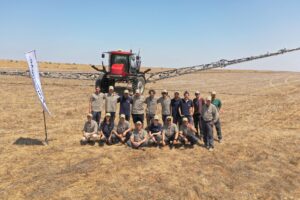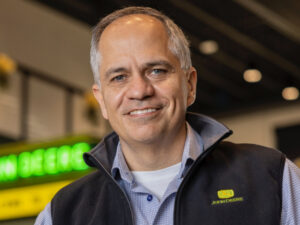Orange Silicon Valley (OSV), the Bay Area innovation division of French telecommunications company Orange, has released a new report focused on agritech, entitled Growing Smarter: Connecting Ag with Tech.
“Considering that $6 billion has been invested across the food system in recent years, I thought somebody in our office needed to do a deep dive into that,” Micki Seibel, a lead researcher for the report, recently told AgFunderNews. “So, I proposed a research project into sustainable food systems.”
With two decades under her belt leading product and user experience teams in Silicon Valley, Seibel decided to target growers cultivating a diverse array of food products in an effort to connect ag with technological innovation. The report represents the culmination of her six months spent in the fields alongside growers and other food system operators.
“My intent was to try and come up with a deeper understanding of the ultimate end user for ag tech products and see if there really is substance there,” says Seibel.
Having spent half a year in the field, there are many takeaways and experiences that Seibel could have highlighted in the report. The theme that stands out most, however, is the need for founders to have meaningful and substantive conversations with farmers about their needs and to incorporate that input into their product designs.
“Given my background in product management, I was able to better understand why that disconnect happens because I saw a lot of ag products being built using typically SV methodologies,” Seibel explains. “You build a buyable product, deploy to customers, iterate fast and often, and that works extraordinarily well with consumer and enterprise products where there are very short cycles.”
It Takes Time to Connect Ag to Tech
In farming, however, time is tied to the seasons. A grower can only cultivate one type of seed each year. Because farmers’ profits are also tied to this timetable, they may be less willing to take a chance on a new product or input. Realizing you’re unsatisfied with the new smart irrigation system you installed, or the new seed varietal you selected, is a much bigger problem than swapping out your cell phone for a different gadget when you’re unsatisfied a few weeks after purchase.
“The companies getting the most traction with growers and gaining the most grower trust are the ones who started by talking to people in ag first and studying the problems firsthand in more of a design thinking methodology,” says Seibel. “They then take that back and build solutions that they can iterate over subsequent growing seasons.”
In recounting her six months of field work, Seibel called out a few particularly memorable moments that underscored how important it is for founders and funders to get their boots muddy.
“We were visiting a chicken farm near Petaluma and it was March. It had been the rainiest week of El Nino on the rainiest day of the week and we were standing in ankle deep mud and chicken feces in the cold. All we wanted to do was take a picture of the chickens and mobile hen houses, but there was no way I was going to pull out my pristine white iPhone 6 for fear of dropping it.”
On another occasion, she recalls visiting a table grape harvest in the Coachella Valley on an especially sunny and warm day. Each time she wanted to see her cell phone, take a picture, or read a message, she had to remove her sunglasses or duck into the shade to see the screen.
“You have to experience those things,” she emphasizes. “It’s not the same when you talk about it or describe it over the phone. You have to experience it to truly understand what you are dealing with.”
Farmers don’t spend most of their day sitting at desks. They’re extremely active and need hardware that can not only take a beating but that can be just as reliable in remote parts of the farm as during the in-store demo. To really vet their products, founders should consider taking them for test drives outside the lab and seeing how they match up to severe rain, wind, bone-chilling cold, and sweltering sun.
From a software standpoint, tasks like inputting data, accessing information, or sending messages need to be simple and user-friendly. Many of these tasks are performed while operating machinery, on horseback, or while performing daily farm chores. If a farmer has to stop what he or she is doing to navigate an unfriendly platform, the farmer is more likely to quit using it altogether.
Along with making sure that founders create products that are rugged and field-ready, Seibel also called out the pesky problem of connectivity. When founders are working on new software or hardware devices, they are often located in an office building where internet connectivity is a piece of cake.
“It was amazing how many times I was standing in a field and there was poor connectivity or no connectivity,” Seibel recounts. “Even when the main farm building had a broadband connection, you may not have access to it out in the field. That lack of connectivity is a big drag on really digitizing agriculture.”
Connect Ag through Conversation
What she hopes readers will glean from the report is the importance of cultivating conversation between growers and the SV community. Founders should spend time with their end user and really empathize with them before heading back to the lab to create a new product. It also wouldn’t hurt to have farmers visit the lab during prototyping or provide input during the design phase. While many consumer products can be developed generally and without specific user feedback like cars, TVs, or even clothes, farmers are a very specific audience who have very specific needs.
Seibel also hopes that the report encourages investors to be more accommodating when it comes to their timelines and returns.
“Traditional SV investors are set up with LP structures that require roughly a 10x return in five years or less. It will take longer than five years to get a return and really prove an agritech product is viable because adoption is slower,” she explains. “You have to deal with multiple growing seasons before you can prove your product.”
Finally, the report is meant to encourage entrepreneurs to tackle problems—perhaps better described as opportunities—in the agritech space.
Seibel’s work isn’t over. She wants to continue studying the intersection of agriculture and technology, particularly by trying to connect startups with growers to bridge the gap.
Having started in the fields and barnyards, her plan is to work through the food supply chain.
“Food is the least digitized supply chain of any industry, so I am going to start doing a deep dive into the next steps down. To me, that involves issues surrounding traceability and transparency.”
Have news or tips? Email [email protected].















Sponsored
International Fresh Produce Association launches year 3 of its produce accelerator